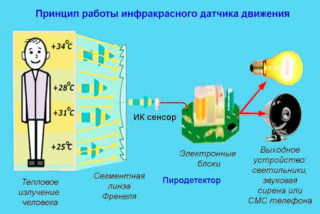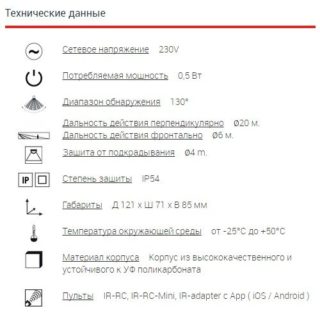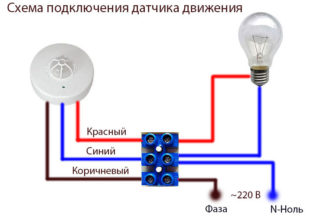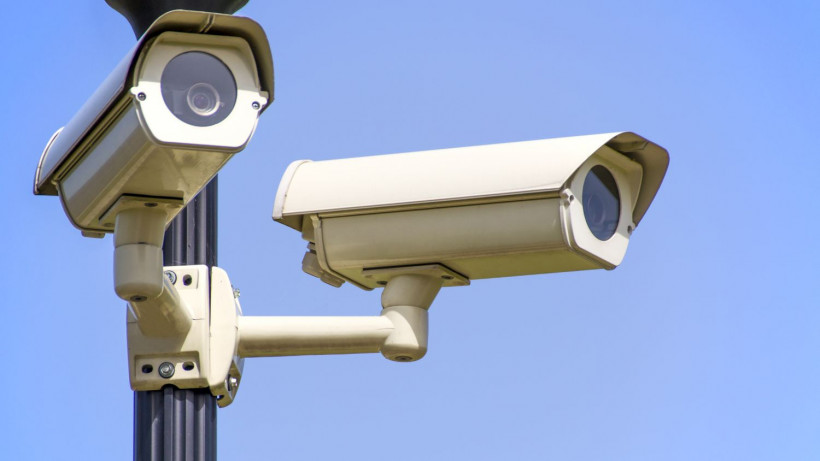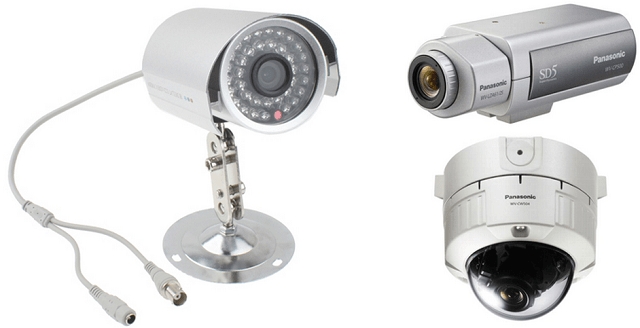The security system is based on various kinds of fixing devices: sound meters, motion recorders. The infrared sensor is the most popular device for detecting moving thermal objects. They are easy to maintain, reliable and quite sensitive.
- How the device works
- Infrared sensor device and design
- Optical system
- Pyrosensitive elements
- Processing module
- Specifications and features
- Comparison with the microwave sensor
- Connection diagram
- Scope of application of the infrared sensor
- Features and selection criteria
- Advantages and disadvantages of an infrared motion sensor
How the device works
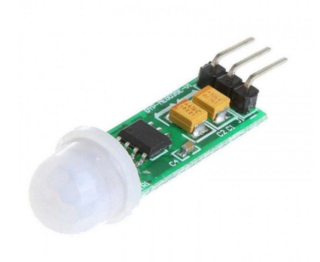
Any object whose temperature is not lower than the air temperature emits heat. The task of the infrared sensor is to highlight it against the general thermal background and, when moving in a given area, send a signal.
A person is a thermal object rather "hot" compared to the walls of an apartment or house, the ground or trees. This allows the sensor to distinguish it from the general background. This also leads to malfunctioning of the alarm if the thermal background in the building is very high.
When a heat object of suitable size and temperature crosses the serviced sector, the meter registers movement. The sensor then sends a signal to the control unit. Depending on what the working device with the sensor is intended for, the control module turns on the light, activates the security alarm, and so on.
The area of operation of the registrar is limited. The detection radius should reach all corners of the room or to the end of the zone in the garden. If this is not the case, mount 2 or more meters. If the device sends a signal to the light switch, the radius may be smaller.
Infrared sensor device and design
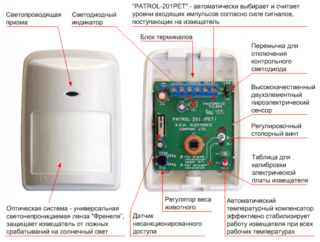
Most devices from different manufacturers are unique in design. However, the general scheme necessarily includes several elements.
Optical system
Most often it is a Fresnel lens. It is a set of prismatic facets - microlenses, fixed on a convex plate - a cylinder. Each lens captures IR radiation in its area and transmits data to the pyrosensitive element. Thus, a certain configuration of the thermal object is created. If the latter does not move, it does not change. But if the object is moving, the same IR flux, when moving, hits the next microlens, and the configuration changes. That is, the light falls on the pyroreceiver, then not. This is the condition for triggering the sensor: the device reacts to the movement of a person in the field of action.
The more segments there are in the lens and the higher their sensitivity, the more accurate the IR sensor works.
If a person moves slowly in the area of the sensor, the device may not work, as it considers fluctuations in the infrared flux as random changes in the background.
Pyrosensitive elements
The signal from the lens goes to a pyroelectric element - a semiconductor converter. It includes 2 sensors, each of which receives a signal from its own lens. If the flow on both elements is the same, the sensor is inactive, if the signal is different, it is triggered.
In modern models, quad sensors are used, serving 4 lenses. They filter out random light interference more accurately and eliminate false alarms.
Processing module
The processing module evaluates the shape and duration of the signal, its amplitude. Normal interference causes asymmetrical bipolar impulses, the intruder produces symmetrical ones. If the nature of the signal matches the threshold value, the sensor is triggered and sends a pulse to the control panel. The latter is processed by analog or digital devices and activates any program: turn on the light, increase the intensity, turn on the siren.
In modern models, the sensor additionally measures the signal duration, the number of times the threshold is exceeded. This allows you to reduce the number of false alarms and fix the object at a slow speed.
Specifications and features
- The mains voltage is normal 230 V. Any of the models operates from a regular mains.
- Power consumption - within 0.5 kW. This makes it possible to equip even a large house with a sufficient number of sensors.
- The detection range is the viewing angle of the device. Measured in degrees. For wall devices, it ranges from 120 to 280 degrees, for ceiling devices - 360.
- Range - measured in meters. This is the distance at which the sensor detects movement. The indicator is assessed by 3 parameters. Perpendicular - the largest zone, determined when the object moves tangentially to the sector. Frontal is measured by moving directly to the sensor, the range of presence is found when a person is under the sensor.
- Protection degree - IP. The first number indicates protection against dust, the second - against water. The minimum reading is 20. The device is protected against touching by fingers, but not protected from water. The highest indicator is 65, such a sensor is mounted in damp rooms.
- Anti-sneak protection - The standard blind spot of the sensor is the space underneath it. In modern models, the system excludes this possibility.
- Air temperature - from -25 to + 50 ° С. Higher temperatures may cause malfunctions.
- Switching capacity - indicates the number of connected lighting devices - up to 40 to 3000 watts.
- Settings - manually, depending on the place of installation, the parameters of sensitivity, illumination and time are adjusted. For different zones, different values are recommended: for the through-passage the shutdown time is 5 minutes, for the working zone - 15. The sensitivity is also determined in accordance with the installation location.
There are other less significant parameters - body material, dimensions, and so on.
Comparison with the microwave sensor
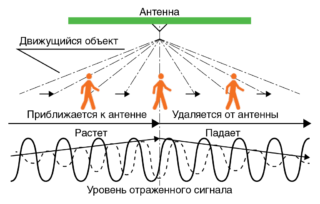
A microwave sensor is also used as a motion sensor. It works according to the radar principle: the device emits a signal, which is reflected and captured by the sensitive element of the sensor. If the reflected signal is higher than the threshold, a light or sound device is turned on.
Microwave sensor differences:
- works in the ultra-high frequency range, which guarantees very high sensitivity;
- detects an object through dielectric obstacles: glass, thin wall, wooden door;
- independent of the temperature of the environment or the degree of illumination of the working area;
- catches slow and slight movement.
There are also disadvantages:
- high price - devices are installed at important economic facilities;
- the operation of the device affects the well-being of people and animals.
For tracking an ordinary private house, IR sensors are quite enough.
Connection diagram
The connection diagram is in the instructions for any device:
- The current comes to the IR sensor from the network through the neutral and phase wires. To connect the device to an electric light bulb, the phase wire is connected to one of the terminals of the lighting device. The second terminal is attached to the zero cable.
- The cables from the devices are connected to the switchboard: 2 wires from the lamp, 2 from the power supply and 3 from the IR recorder. The phase of the supply wire is connected to the phase cable of the sensor, and the neutral wire from the power supply and the neutral cable from the sensor are connected to the neutral cable from the luminaire.
- The phase cable from the IR sensor is connected to the wire from the lamp. All cables are color-coded to facilitate connection.
If the lighting must be maintained for some time regardless of human movement, a switch is also included in the circuit in parallel with the IR device.
Scope of application of the infrared sensor
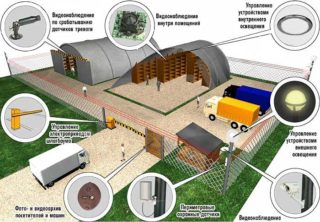
Motion recorders are used to organize lighting and security systems. Installation is allowed both inside the building and outside:
- in office, public and private buildings;
- on stairwells of apartment buildings and in entrances;
- in rooms of any type;
- in warehouses;
- in any protected area with a limited area.
Devices designed for operation in severe weather conditions are equipped with additional protective devices.
Features and selection criteria
The parameters by which the sensor is selected are determined by its technical characteristics. It is important to assess what kind of indicators are needed for a device that works in the home, outside the home or in an open area:
- For large rooms or a courtyard, devices with a large detection area are selected. Simple models with a range of 10, 6 and 4 m are bought in a small room or on a staircase.
- For living rooms, options with low moisture protection are suitable. Outdoor or wet rooms (swimming pools, hospitals) need products with a high IP.
- If the device is going to be wall-mounted, it is better to buy a model with anti-sneak protection. Otherwise, moving along the wall, an intruder will be able to enter the house.
- Sensitivity level - determines how slow and small movements the sensor can pick up. To protect the apartment from thieves or to turn on the lighting in the room when they enter it, there are enough "rough" devices. Sensitive sensors are bought in warehouses where expensive or dangerous products are stored.
Assess the cost of devices, especially if several of them are required for the security system.
Advantages and disadvantages of an infrared motion sensor
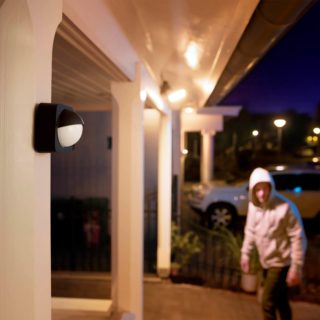
The popularity of IR models is due to their advantages:
- the device works both inside the building and outside;
- the viewing angle and range can be fairly accurately adjusted;
- The infrared sensor, especially the passive type, is safe for health, the operation of the security system does not frighten pets;
- low cost;
- a wide range of products: floor-standing and wall-mounted devices, analogue, digital, and others are produced.
Main disadvantages:
- when exposed to direct sunlight, the sensitivity drops - when choosing an installation site, this must be taken into account;
- when an air conditioner or heater is placed close, significant interference occurs;
- glass blocks the signal, so there are blind spots that an attacker can use;
- cobweb syndrome - a sensor entangled in cobwebs is constantly activated.
A single motion sensor does not guarantee the safety of the room. However, as an element of the protection system, infrared devices are irreplaceable. For a country house or apartment, such devices are preferable.

